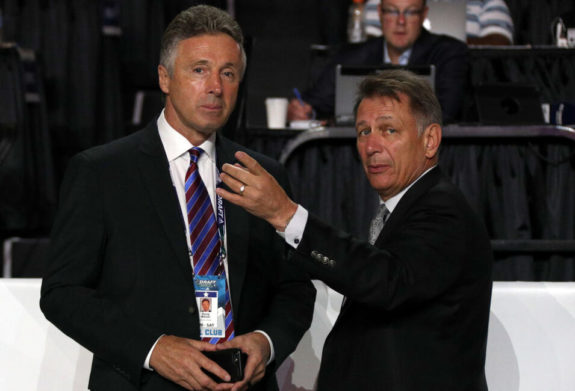Due to the protocols put in place by the NHL to limit the spread of COVID-19, player movement at the 2021 NHL Trade Deadline will likely be impacted.
As it currently stands, players must quarantine for seven days after moving from one team to another – whether that’s through a trade, signing as a free agent, or waivers.
“The quarantine issue is just another layer you take into consideration when evaluating any transaction,” Calgary Flames general manager Brad Treliving told The Athletic’s Pierre LeBrun. (from ‘LeBrun: How will quarantine rules affect Canadian teams’ trade deadline plans?’ – The Athletic – 1/29/21)
“At the end of the day, it won’t be the overriding factor in determining whether a team will make a move but it is real and you make it part of your planning and layering when going through that process as in when will the acquiring player be available to you.”
With that in mind, let’s take a look at just how COVID-19 could impact the trade deadline.
Quarantine Regulations & Missed Games
As I mentioned above, players have to quarantine for seven days after they join a new team. Due to the NHL’s compressed schedules, that means missing three or four games, depending on the acquiring team.
It could be longer, too. If a Canadian team acquires a player from an American franchise, said player would need to quarantine for 14 days after arriving in Canada. This was the case for Pierre-Luc Dubois after the Columbus Blue Jackets shipped him to the Winnipeg Jets for Patrik Laine and Jack Roslovic.

Wider vaccine distribution could remedy this. If the NHL is able to procure COVID-19 vaccines for its players and staff (after first responders, front-line workers, and others with an elevated risk are attended to, of course), quarantine rules could potentially be relaxed.
But until then, how do teams improve for the stretch run and playoffs? One option would be to trade earlier in the season, rather than wait for the April 12 deadline.
Related: Pandemic Trades No Easy Task for NHL General Managers
For a contending team like the Colorado Avalanche, their internal trade deadline could be a month prior, giving their new acquisitions additional time to build chemistry before the postseason begins. If teams take this approach, we could see trades occur over a longer period of time, rather than a flurry of moves at the deadline itself.
Impact on Trading Draft Picks
Complicating matters further is the uncertainty surrounding the 2021 NHL Draft. As of now, it’s scheduled for July 23-24, though that could change.
It should be noted, though, that the NHL has not openly discussed the possibility of moving the draft – this has just been speculation and wishful thinking to this point.
“There have been no decisions made on changing the draft date to our knowledge, just discussions; and any decision would require NHLPA approval. Teams, until told otherwise, are still preparing for a draft in July, and most have already had mid-year amateur meetings in preparation for that.”
–Corey Pronman (from ‘Pronman: Delay the NHL Draft? Teams propose changes but waiting has a cost’ – The Athletic – 2/1/21)
Between the draft potentially moving to a new date and the minimal amount of in-person scouting over the past year, teams could re-evaluate how they manage their draft picks. Some may be more willing to trade their selections, thinking they can still draft the players they want in later rounds. Others may be betting they have a leg up on scouting comparatively and will want to hold all their picks (and acquire more).
Related: Who is the NHL’s Top Goaltending Prospect?
Nonetheless, the draft is another added wrinkle in how COVID-19 will impact the trade deadline this year.
Fewer Deadline Trades?
With the quarantine and draft factors in play, we could see a relatively quiet trade deadline this year. Instead, most trades could take place in the months or weeks leading up to the April 12 deadline.

This would be a stark contrast from the 2019-20 season, when 45 percent of all 2019-20 in-season trades took place on February 24 – the trade deadline. Further, 72 percent of all trades occurred in February. This most certainly won’t be the case come April.
So if teams trade for players earlier in the season, could we see a sellers’ market? More teams will be in the playoff race, so it’s entirely possible.
Bottom-feeders like the Ottawa Senators, Detroit Red Wings, and San Jose Sharks could control the market to some degree. Ottawa, in particular, has an interesting advantage, according to LeBrun:
“If those top six Canadian teams want to avoid acquiring a player from a U.S. team and deal with the 14-day quarantine, a trade with Ottawa would mean that player likely only quarantines for 48 hours because it’s within Canada (as long as he takes a private charter to his new city).”
Pierre LeBrun (from ‘LeBrun: How will quarantine rules affect Canadian teams’ trade deadline plans?’ – The Athletic – 1/29/21)
Additionally, the Senators and Red Wings are flush with cap space. They could be intriguing trade partners for teams up against the salary cap upper limit looking to bolster their lineup for the playoffs.
Final Word
There are a variety of factors that will play into how teams will approach the trade deadline – quarantine protocols, government regulations, vaccine distribution schedules, and the 2021 draft are just a few variables being considered.
If everything remains the same over the next couple months, we could see more trades leading up to the trade deadline, rather on the actual deadline itself. That said, teams need to be ready to pivot at a moment’s notice if any of the elements mentioned above change in the coming days.
Whether or not there’s an impact on the trade deadline, everyone’s safety is the top priority. Trades can wait – health cannot.